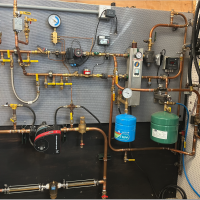Oil tank slowly dripping from bottom
Recently had HVAC technician replace oil filters as part of annual maintenance. Noticed very very slow drip of oil from highlighted section. When I say slow, I mean 1 “drop” per day. A drop is also an overstatement. I am wondering if the seal is wearing down on the pipe leading to this? Attached a few photos. Obviously would like to get this rectified before it’s a bigger issue. Is this something HVAC company I use should fix? A plumber? Heating oil tank company? Not entirely sure where to go from here.
When I run paper towel under the pipe, it has a bit of heating oil on it. The blue bowl is where it is falling into the ground. Just bought the house and this is the first time the boiler has been serviced in God knows how long and same for the new oil filter replacement.
Comments
-
Well, it is not the tank so that is good. I would have whoever works on the burner fix it. If the leak is that small just keep a pan under it and have it fixed the next time you get service.
Make your service provider aware of this and that they should have fixed it while they were there. Doesn't your oil provider have an oil technician?
Your best bet is to buy your oil from a service provider who sells oil and has a service dept. They are the ones with the incentive to help you out. If you by oil from someone who only sells oil they may have a cheaper price but can't help you because they have no service dept.
1 -
You may have to pay for it, unless you can convince the HVAC technician that he/she owns this issue because "it was fine before the filter was replaced". You can expect some push back: "it was fine when I left", but you may get at least a discounted service visit.
I notice the 1/2" Y joint is cast iron. It would be better to use a copper Y joint there, to avoid (minimize) dielectric corrosion. When dissimilar metals are joined, used a liberal amount of pipe thread compound, to keep the metals separated as mucghas possible. If this was me, I would replace the y joint, the 2 flare fittings to start with. Not necessarily the flare nuts and would not re-flare the pipes . Flare joints rarely leak.
0 -
What I see is the spin on filter can't even sit vertical, so forget getting a filter wrench on it. So the tech spun the whole assembly. As did every tech previously. As will every tech in the future. Have it piped properly so it can be serviced properly. And two oil lines but only one protected by an OSV.
0 -
All though I have not done it, I think the filter can be installed horizontally.
As to concerns about electrolysis. It's not really a thing when piping oil. At least not in this case.
If I was the one called back to this I probably would change all of the fittings. Oil has a funny way of finding its way out more so then anything else and I have piped a lot of different stuff.
Thankfully this is a very small micro leak and doesn't seem to need immediate attention.
0 -
The tech that installed this may have used a thread compound that is subpar for heating oil. If that is the case, the leak will get worse. I would fix it/ have it fixed if it was my house. Even just taking apart the "right side" from the filter and re-doping ithe joints t with something like Gasoila may fix this. Of course the seal may be leaking on the contraption on the right. What is that btw? Some type of pump? I dont see any power going to it…. I see the point some make that there is no mount for the filter to take the stress of unwinding the filter when it is being replaced. Whenever the filter is replaced, you or the tech can just grab and hold the top of the filter housing with a wrench and counter-hold to keep the connections from getting stressed.
0 -
It's an OSV valve.
0 -
where does the pipe go coming off before the osv
0 -
@mrcoder has some experience with fuel lines as I can see from his discussion back in March. I am not sure that he has the same experience as say @EBEBRATT-Ed , @HVACNUT or others herein. I am interested in @mrcoder ’s experience with fuel lines that use dissimilar metals over a long period of time. Have you actually experienced a problem related to this mixing of different metals on fuel oil lines? I have worked on fuel oil feed lines from oil tanks to oil burners and often use steel pipe nipples with malleable iron fittings, brass fittings and copper tubing connected to aluminum filter housings. In my 45 years of working on those systems I have not experienced this phenomenon. Some of those combinations were in place for over 70 years in many cases. Is there something new happening to fuel oil lines since I retired from the trade? Do you attribute it to the fact that some fuel dealers are delivering BioFuel to these older multi-metal piping systems? I am interested in your experiences since you are offering the information as a criticism of the folks that installed those combination metals as a possible flaw in the workmanship. I am always interested in any new developments in the fuel oil burner service trade.
As far as that aluminum device that you refer to as "…the contraption on the right. What is that btw? Some type of pump?" is called an oil safety valve (OSV) if you want to understand it look at this LINK for more information. That way you will have more information for future criticisms you may feel the need to offer.
Edward Young Retired
After you make that expensive repair and you still have the same problem, What will you check next?
0 -
Have them replace that cast tee , with an brass or iron tee … Just a bad pick out of the truck …
Hope this Helps
There was an error rendering this rich post.
0 -
Looks like a malleable iron tee. Cast iron tees have a larger wrenching surface. That 3/8" tee has the smaller wrenching surface commonly found on galvanized and malleable fittings. Those fittings will not crack as easily as a Cast iron fitting and therefore approved for fuel line like the one in the photo.
Edward Young Retired
After you make that expensive repair and you still have the same problem, What will you check next?
0 -
On second look one oil line is unprotected by the OSV and one is protected. I suspect the burner may be hooked up two pipe with the protected being the suction and the other line is the return
1 -
Agree Ed. I am still interested in @mrcoder's experience with fuel lines that contain steel, cast iron, malleable iron, brass, copper, and aluminum. With the certainty of his statement above, I want to know what has changed since I retired in 2019. Have there been a surge in dissimilar metals used in fuel lines begin to deteriorate at an accelerated? Has anyone else experienced this problem? I like that this new member has important information to share with all of us here. I would hope that this new member might be just a little more delicate when describing the work of others they feel is inferior to their higher level of craftsmanship.
I know that when I had less than 100 posts back in 2004, I was happy to get advice from this forum. I made it a habit of paying it foreword. When I asked about something I didn't know about and got some very good answers from "The Wall", I would select a minimum of 3 questions that I had a Iron clad answer for. I got help from old-timers like @john_35 or @Ray Landry who were members before me, and helped me. To pay it foreword, I might answer a circulator pump query or an oil burner control problem with the authority of knowing that I had to correct answer to solve a problem for someone else. I didn't have the time stay online as much time as I have now, so my time on here was limited. After 45+ years experience and this disability, I have nothing better to do but solve the problems of the world, one oil burner nozzle at a time.
Edward Young Retired
After you make that expensive repair and you still have the same problem, What will you check next?
3 -
Ed, you are right.
I generalized, unreasonably.
All the instances of dielectric corrosion I have seen were on water lines, not on fuel lines.
Now that I think about it, oil is not an electrolyte, I stand corrected. Thanks !0 -
Yeah, fuel oil, a hydrocarbon is not a very conductive fluid to support galvanic corrosion. O2 also speeds up the reaction.
The conductivity of water depends on the TDS, the amount of minerals in the water, for example.The German DIN standard for boiler water suggested DI or RO water for boilers as it is also very low conductivity. Ph needs to be adjusted in purified water.
Bob "hot rod" Rohr
trainer for Caleffi NA
Living the hydronic dream1 -
Hopefully the fuel line not protected isn't a return.
0 -
Looking closely at the original photo, both fuel lines have the orange outer protection, so all those concerned can now sleep better tonight.
Edward Young Retired
After you make that expensive repair and you still have the same problem, What will you check next?
0
Categories
- All Categories
- 87.3K THE MAIN WALL
- 3.2K A-C, Heat Pumps & Refrigeration
- 61 Biomass
- 427 Carbon Monoxide Awareness
- 119 Chimneys & Flues
- 2.1K Domestic Hot Water
- 5.8K Gas Heating
- 115 Geothermal
- 165 Indoor-Air Quality
- 3.7K Oil Heating
- 76 Pipe Deterioration
- 1K Plumbing
- 6.5K Radiant Heating
- 395 Solar
- 15.6K Strictly Steam
- 3.4K Thermostats and Controls
- 56 Water Quality
- 51 Industry Classes
- 50 Job Opportunities
- 18 Recall Announcements










